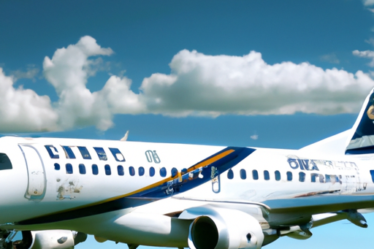
Key Factors Driving the Growth of Asia Pacific Airlines in May 2023
Asia Pacific Airlines Report 21.4 Million International Passengers in May 2023
The Asia Pacific region has witnessed a remarkable growth in the aviation industry, with Asia Pacific airlines reporting a staggering 21.4 million international passengers in May 2023. This surge in passenger numbers can be attributed to several key factors that have been driving the growth of the aviation industry in the region.
One of the primary factors contributing to this growth is the increasing disposable income of the middle-class population in Asia Pacific countries. As economies in the region continue to flourish, more people are able to afford air travel, leading to a higher demand for flights. This rise in disposable income has also resulted in a shift in consumer preferences, with more individuals opting for air travel as a convenient and time-saving mode of transportation.
Furthermore, the Asia Pacific region has witnessed a significant increase in tourism, both inbound and outbound. Countries like China, Japan, and Thailand have become popular tourist destinations, attracting millions of visitors each year. This influx of tourists has created a surge in demand for flights, as travelers from all over the world seek to explore the rich cultural heritage and natural beauty of these countries.
In addition to tourism, the Asia Pacific region has also experienced a boom in business travel. With the rise of multinational corporations and globalization, more professionals are required to travel across borders for meetings, conferences, and business negotiations. This has led to a substantial increase in the number of business travelers, further driving the growth of the aviation industry in the region.
Another key factor driving the growth of Asia Pacific airlines is the expansion of airline networks and routes. Airlines in the region have been actively expanding their operations, adding new destinations and increasing flight frequencies. This has not only provided travelers with more options but has also made air travel more accessible and affordable. The increased connectivity has facilitated easier travel between countries, encouraging more people to explore different parts of the Asia Pacific region.
Moreover, advancements in technology have played a significant role in the growth of the aviation industry. The introduction of online booking platforms and mobile applications has made it easier for travelers to plan and book their flights. Additionally, the use of advanced aircraft and improved infrastructure has enhanced the overall travel experience, making air travel more comfortable and efficient.
Lastly, the Asia Pacific region has witnessed a surge in low-cost carriers, offering affordable air travel options to budget-conscious travelers. These airlines have revolutionized the industry by providing competitive fares and flexible travel options. The presence of low-cost carriers has not only increased competition among airlines but has also made air travel more accessible to a wider range of travelers.
In conclusion, the growth of Asia Pacific airlines in May 2023 can be attributed to several key factors. The increasing disposable income, rise in tourism and business travel, expansion of airline networks, advancements in technology, and the presence of low-cost carriers have all contributed to the surge in passenger numbers. As the region continues to develop and prosper, it is expected that the aviation industry will continue to thrive, providing more opportunities for travelers to explore the diverse and vibrant Asia Pacific region.
Analysis of the Top Destinations for International Passengers in Asia Pacific Airlines Report

Asia Pacific Airlines Report 21.4 Million International Passengers in May 2023
The Asia Pacific region has long been a popular destination for international travelers, and the latest report from Asia Pacific Airlines confirms this trend. In May 2023, a staggering 21.4 million international passengers flew with airlines in the region, highlighting the continued growth and appeal of Asia Pacific as a travel destination.
When analyzing the top destinations for international passengers in the Asia Pacific Airlines report, several key trends emerge. One of the standout destinations is Japan, which attracted a significant number of visitors in May. With its unique blend of ancient traditions and modern innovations, Japan has always been a favorite among travelers. From the bustling streets of Tokyo to the serene beauty of Kyoto, there is something for everyone in this captivating country.
Another popular destination in the Asia Pacific region is Thailand. Known for its stunning beaches, vibrant street markets, and rich cultural heritage, Thailand offers a diverse range of experiences for travelers. Whether it’s exploring the bustling city of Bangkok, relaxing on the pristine shores of Phuket, or immersing oneself in the spiritual tranquility of Chiang Mai, Thailand has something to offer every type of traveler.
Singapore, a small but mighty city-state, also features prominently in the Asia Pacific Airlines report. Renowned for its cleanliness, efficiency, and modernity, Singapore has become a hub for business and leisure travelers alike. From its iconic Marina Bay Sands hotel to its world-class shopping and dining options, Singapore offers a luxurious and cosmopolitan experience for visitors.
Moving further south, Australia emerges as another top destination in the Asia Pacific region. With its stunning landscapes, unique wildlife, and vibrant cities, Australia has long been a dream destination for many travelers. From the iconic Sydney Opera House to the breathtaking Great Barrier Reef, Australia offers a wealth of natural wonders and cultural experiences that continue to attract international visitors.
In addition to these well-known destinations, the Asia Pacific Airlines report also highlights the growing popularity of emerging destinations such as Vietnam and Indonesia. Vietnam, with its rich history, delicious cuisine, and stunning landscapes, has become an increasingly popular choice for travelers seeking an authentic and immersive experience. Similarly, Indonesia, with its diverse archipelago of islands, offers a wide range of experiences, from the cultural wonders of Bali to the natural beauty of Komodo National Park.
Overall, the Asia Pacific Airlines report paints a picture of a region that continues to captivate and attract international travelers. From the ancient traditions of Japan to the stunning beaches of Thailand, the cosmopolitan allure of Singapore, and the natural wonders of Australia, there is no shortage of destinations to explore in the Asia Pacific region. Whether it’s a bustling city adventure or a tranquil beach getaway, Asia Pacific offers something for every type of traveler. With its diverse cultures, breathtaking landscapes, and warm hospitality, it’s no wonder that millions of international passengers choose to fly with Asia Pacific Airlines each month.
Challenges Faced by Asia Pacific Airlines in Managing Increased Passenger Traffic in May 2023
Asia Pacific Airlines Report 21.4 Million International Passengers in May 2023
Asia Pacific Airlines have experienced a significant increase in passenger traffic in May 2023, with a staggering 21.4 million international passengers reported. While this surge in numbers is undoubtedly a positive sign for the industry, it also presents several challenges for airlines in managing the increased demand.
One of the primary challenges faced by Asia Pacific Airlines is the strain on infrastructure and resources. With such a sudden influx of passengers, airports and airlines must ensure that they have the capacity to handle the increased volume. This means having enough check-in counters, security personnel, and boarding gates to accommodate the growing number of travelers. Additionally, airlines must also have enough aircraft available to meet the demand, which may require adjusting flight schedules and increasing fleet size.
Another challenge is ensuring the safety and security of passengers amidst the increased traffic. With more people traveling, there is a higher risk of accidents, delays, and security breaches. Airlines must be proactive in implementing measures to mitigate these risks, such as enhancing safety protocols, increasing staff training, and improving communication systems. Additionally, airports must also be prepared to handle emergencies and provide adequate medical facilities to cater to any unforeseen circumstances.
Managing customer expectations is also crucial during this period of increased passenger traffic. With more people traveling, there is a higher likelihood of delays and disruptions. Airlines must communicate effectively with their customers, providing timely updates and assistance in case of any inconveniences. This can help alleviate frustration and ensure a positive travel experience for passengers.
Furthermore, the surge in passenger traffic also poses challenges in terms of maintaining operational efficiency. Airlines must streamline their processes and optimize their resources to ensure smooth operations. This may involve implementing new technologies, such as automated check-in systems and self-service kiosks, to reduce waiting times and improve overall efficiency. Additionally, airlines must also work closely with airport authorities and other stakeholders to coordinate operations effectively and minimize bottlenecks.
The increased passenger traffic also puts a strain on the environment. With more flights taking off and landing, there is a higher carbon footprint associated with air travel. Airlines must take responsibility for their environmental impact and work towards implementing sustainable practices. This may involve investing in more fuel-efficient aircraft, exploring alternative energy sources, and offsetting carbon emissions through initiatives such as tree planting or carbon offset programs.
In conclusion, the surge in international passenger traffic in May 2023 presents several challenges for Asia Pacific Airlines. From managing infrastructure and resources to ensuring safety and security, airlines must be proactive in addressing these challenges. Effective communication with customers, maintaining operational efficiency, and implementing sustainable practices are also crucial in managing the increased demand. By overcoming these challenges, Asia Pacific Airlines can continue to provide a positive travel experience for passengers while contributing to the growth and development of the aviation industry in the region.


